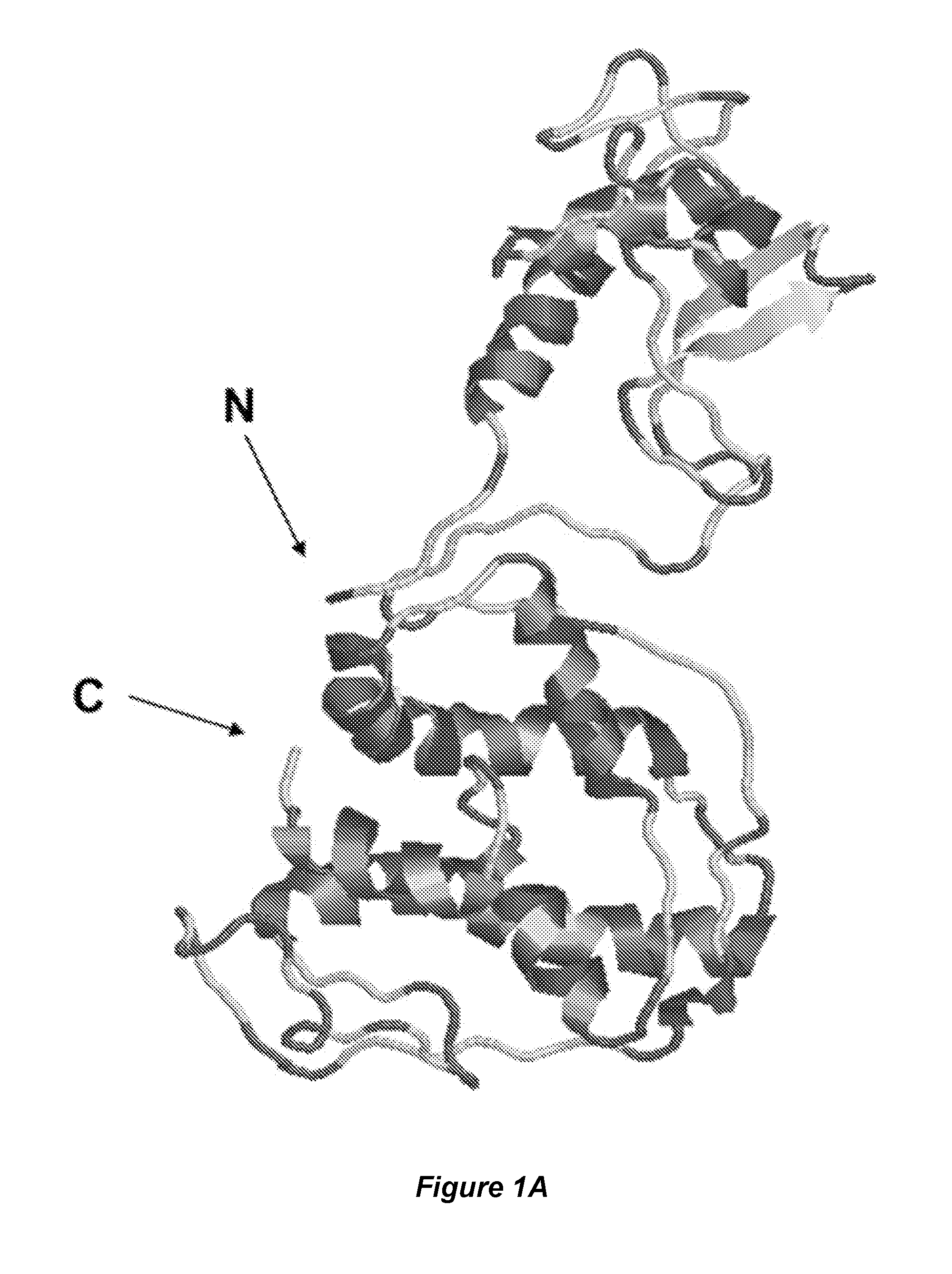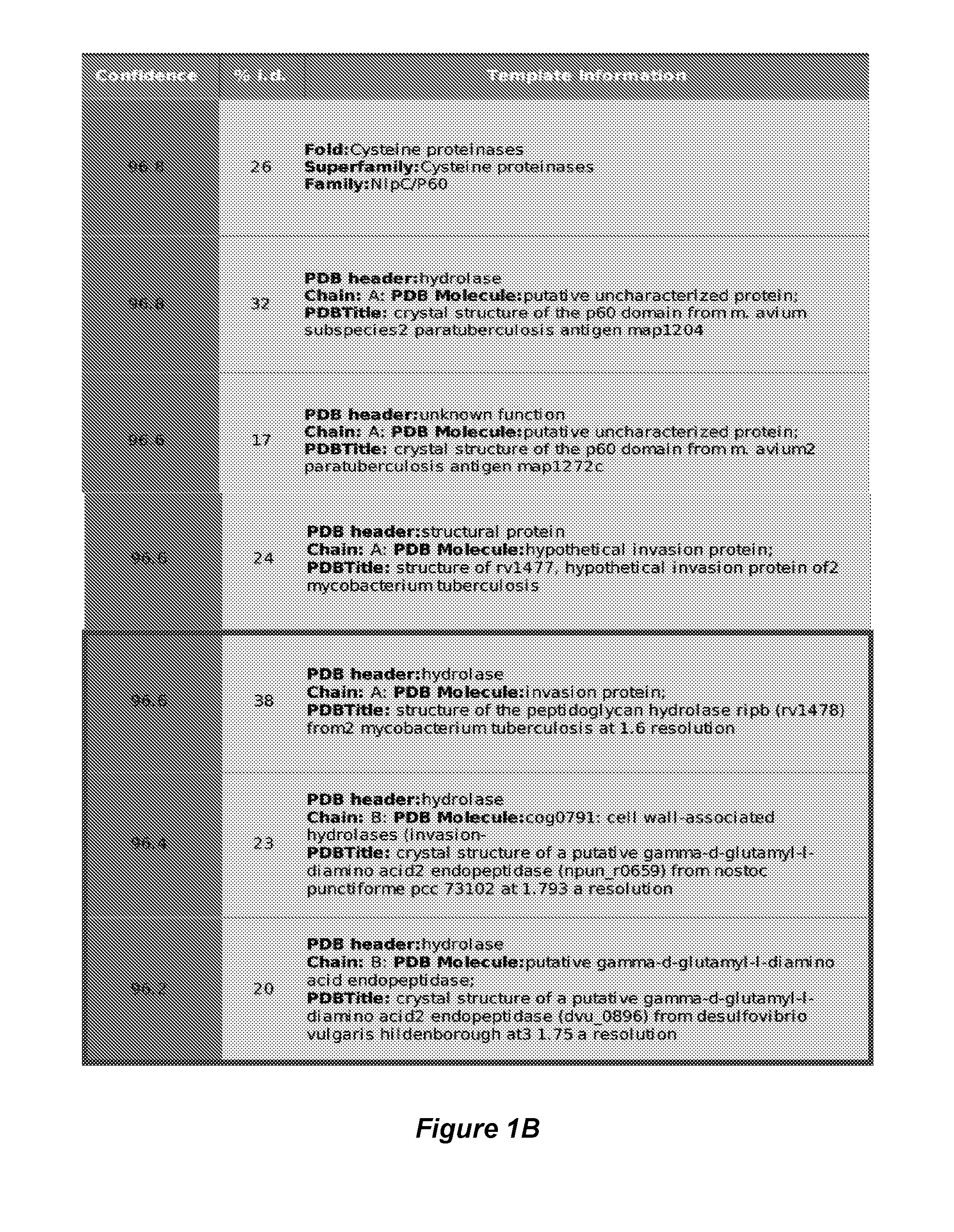Diagnosis and treatment of mycobacteria infections
a technology for mycobacteria infection and diagnosis, applied in the field of diagnosis and treatment of mycobacteria infections, can solve the problems of inability to easily identify carriers, difficult to grow maps on artificial media, and inability to quickly and reliably test for the identification of carriers, so as to enhance improve the sensitivity of diagnostic assays
- Summary
- Abstract
- Description
- Claims
- Application Information
AI Technical Summary
Benefits of technology
Problems solved by technology
Method used
Image
Examples
example 1
Identification and Production of Mycophage Receptor Binding Proteins
[0084]The search for the mycobacterium phage receptor binding protein (RBP) was performed on the basis of the known genome sequence of bacteriophage L5 that was the first genome sequence obtained for the temperate non Escherichia coli phage (Hatfull G F, Sarkis G J. Mol. Microbiol. (1993) 7(3):395-405). L5 phage has a broad host range and can infect not only benign Mycobacterium smegmatis, but also M. tuberculosis and Mycobacterium avium subsp. paratuberculosis cells. The nature of the L5 mycophage receptor(s) is still unknown.
[0085]Genes encoding L5 phage tail proteins and genes adjacent to the genes of the tail proteins were selected as candidate RBP genes. Recently released Protein Homology / analogY Recognition Engine v. 2.0 (Phyre2) software (Structural Bioinformatics Group, Imperial College, UK) was used to analyze the amino acid sequence of these proteins to choose the RBP candidates. Gp-6, Gp-10 and Gp-31 were...
example 2
Assessment of Mycophage and Mycophage RBPs as Probes of MAP Infection
[0091]In order to assess mycophage and mycophage RBPs for their use as probes of MAP infection, Gp-10 and Gp-6 were immobilized using an established protocol (Singh et. al. Biosens. Bioelect. 26 131 (2010) and used for the specific bacterial capture. Gold Surfaces were modified by cysteamine hydrochloride followed by activation using 2% gluteraldehyde. The recombinant proteins Gp-10, Gp-6 and Gp-31 were immobilized over the surfaces in order to capture the host bacteria Mycobacterium avium subsp. paratuberculosis ATCC 19851 and Mycobacterium smegmatis mc2155. Bacterial capture was confirmed by fluorescence microscopy and Scanning Electron Microscopy (SEM). Nonspecific attachment was prevented by using bovine serum albumin (BSA) as the blocking layer. A negative control was run in parallel where a similar gold surface was treated with all reagents, but they were not exposed to the recombinant phage proteins. No sign...
example 3
Assessment of Mycophage RBPs as Probes for Detection and Isolation MAP Contamination in Milk
[0093]In another embodiment of the invention, immobilization of GP-10 was achieved by commercially available magnetic beads Dynabeads® M-280 Tosylactivated (AsSE Invirtogen, USA) and those functionalized beads were applied for specific bacterial capture. 20 μl of 100 mg / ml Tosylactivated beads were suspended in 1 ml of 0.1 M Na-phosphate buffer (pH 7.4) (PBS) and washed twice in sterile PBS. The beads were separated from any liquid suspension by using magnet. The cleaned beads were incubated with 100 μg / ml Gp-10 and GP-6 for 1 hour at 37° C. followed by overnight incubation at room temperature. The functionalized beads were further incubated in 1 mg / ml BSA for 30 min to block the free surface and prevent nonspecific binding. The beads are washed twice in PBS to remove the unbounded BSA.
[0094]1, 2 and 3% of Difco skimmed milk (BD Company MD, USA) in 0.1 M Na-phosphate buffer (pH 7.4) (PBS) was...
PUM
| Property | Measurement | Unit |
|---|---|---|
| concentration | aaaaa | aaaaa |
| pH | aaaaa | aaaaa |
| temperature | aaaaa | aaaaa |
Abstract
Description
Claims
Application Information
 Login to View More
Login to View More - R&D
- Intellectual Property
- Life Sciences
- Materials
- Tech Scout
- Unparalleled Data Quality
- Higher Quality Content
- 60% Fewer Hallucinations
Browse by: Latest US Patents, China's latest patents, Technical Efficacy Thesaurus, Application Domain, Technology Topic, Popular Technical Reports.
© 2025 PatSnap. All rights reserved.Legal|Privacy policy|Modern Slavery Act Transparency Statement|Sitemap|About US| Contact US: help@patsnap.com



